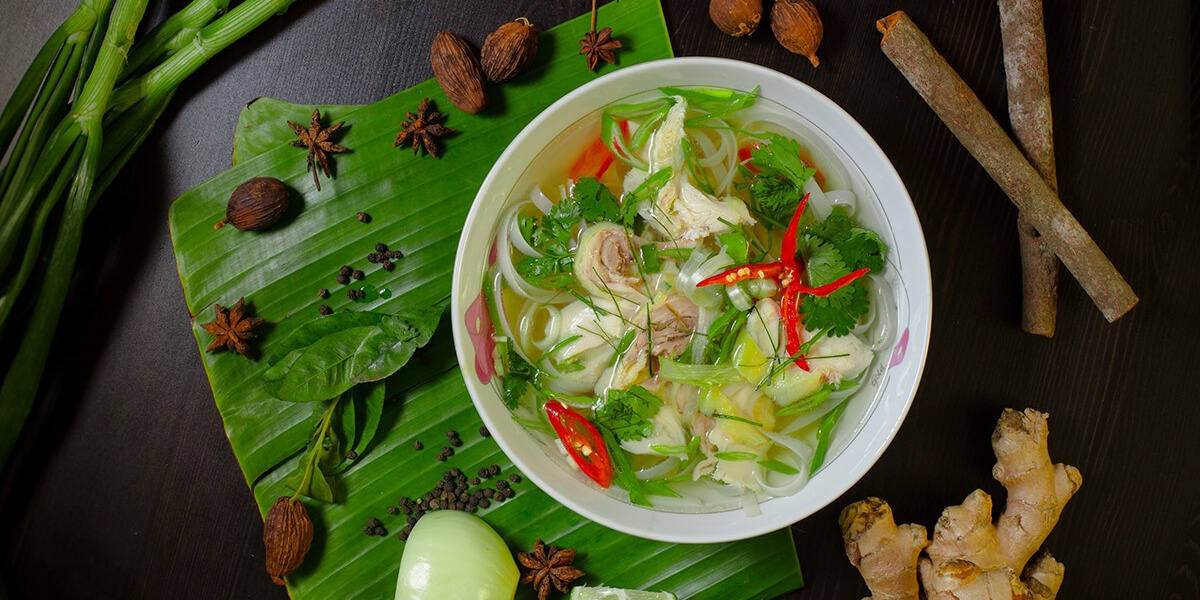The main dishes in a meal in Vietnam usually have to be full of nutrients, often including rice, vegetables, meat, or fish (protein in general). But that doesn’t mean it’s easy to eat, especially if the food is greasy or under-seasoned, the appetite will disappear very fast. Every Vietnamese side dish exists for that situation, helping each main dish become more special and attractive.
1 - Vietnamese side dishes from pickled foods
Possessing a delicious sweet and sour taste, pickles have the ability to stimulate the taste buds, blurring the grease in dishes. This is one of the most loved side dishes in Vietnam, especially on Tet holidays when there are many Banh chung and meat. Eating a rustic meal in Vietnam, you will more often see pickles made from vegetables, then tubers, and fruits, while meat, fish, milk, or eggs pickles exist but are much rarer to see.
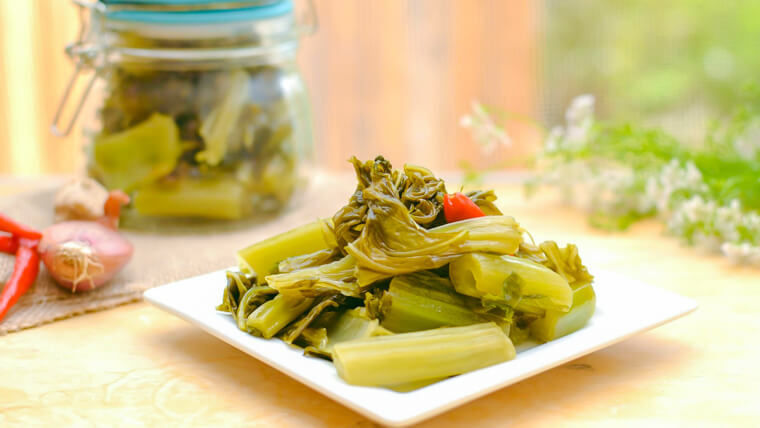
Pickled foods are extremely popular Vietnamese side dishes - Source: chiecthiavang
Pickling is actually a way of preserving or extending the shelf life of food by anaerobic fermentation in brine or in vinegar, altering its texture and flavor. One or more vegetables, roots, or fruits are mixed together and added salt, sugar, and sometimes vinegar in a certain ratio based on the experience of the cook. Depending on the ingredients and processing methods, there are hundreds of kinds of pickles in Vietnam, with two main types namely quick pickles and salty pickles.
Quick pickles are also one of most favored Vietnamese side dishes. As the name suggests, pickles are usually made in a short time and eaten within the same day, with a fairly mild sour taste, sometimes even still spicy and pungent. Commonly used ingredients include vegetables and fruits such as eggplant, cabbage, kohlrabi, carrots, green papaya, cauliflower, and so on. Salt and sugar are mixed with water in a moderate ratio, sometimes combined with a little vinegar or lemon juice to create a sour taste. The ingredients are thinly sliced so that when soaked in the mixture created above, the flavor can be absorbed in a short time.
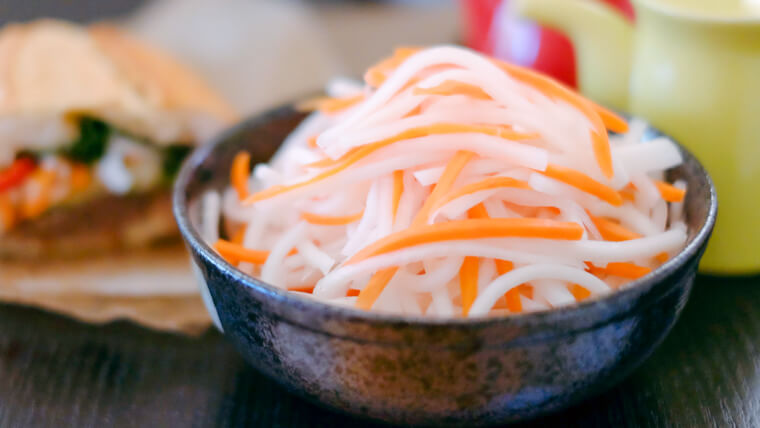
Vietnamese pickled carrot and daikon - Source: onegirlcatering
Meanwhile, Vietnamese side dishes from salted pickles have a longer pickling time and longer shelf life, often increasing the salinity of the ingredients, which are often vegetables and fruits. They are often dried in the shade to slightly wilt, making the ingredients more crispy and delicious, having a beautiful golden color. The makers can cut thick, larger pieces or leave the ingredients whole so that the pickles are not too sour and can last longer. Salt pickles can be made with salted brine or alternating a layer of ingredients and a thin layer of granulated salt, then compacted tightly with heavy objects and covered.
Vietnamese side dishes from pickles can be eaten as vegetables in a regular meal, but they are often seen as an accompaniment to oily and fatty dishes. In particular, you will find them more on holidays such as the Tet holiday with pickled onions, pickled carrots, and pickled kohlrabi,... There are also some special pickles that are indispensable parts of other dishes, such as sauerkraut with roasted meat, pickled figs with boiled snails, pickled sliced kohlrabi, and papaya with Bun cha,… If there is scum on the surface, it means that the pickles have been left for a while, very sour and sometimes spoiled.
2 - Vietnamese vegetable side dishes
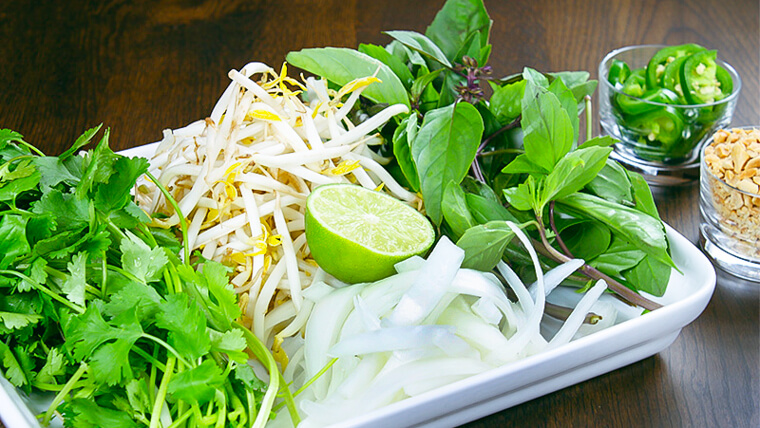
Fresh vegetables & herbs - Source: thewandertheory
Raw vegetables are a general name for vegetables and leaves used as Vietnamese side dishes in meals and parties, which can be eaten raw or bare through boiling water. They are usually herbs and spices, which have the effect of appetizing when eating fish dishes, oily and fatty meat, or grilled, roasted dishes,...
The way to add raw vegetables is also quite diverse, including rolling with savory dishes, blanching in hotpots, or chopping and adding to noodle dishes. Some of the raw vegetables that are most often eaten are lettuce, water spinach, herbs, and spices such as basil, perilla,... Providing a quantity of nutrition, which is preserved more intact than when cooked, these Vietnamese side dishes are not only refreshing for meals but also good for health
Vietnamese vegetable side dishes are extremely common, but there are many recommendations that eating them has a high risk of parasitic infections. Especially when they are not hygienic, Vietnamese vegetables now carry pathogens that cause digestive tract infections, helminths, and pesticide poisoning. So it is necessary to check out the food shops if you eat outside, look closely at the place where the food is cooked and prepared, and don’t eat too much.
3 - Top 4 Vietnamese side dishes: Quay
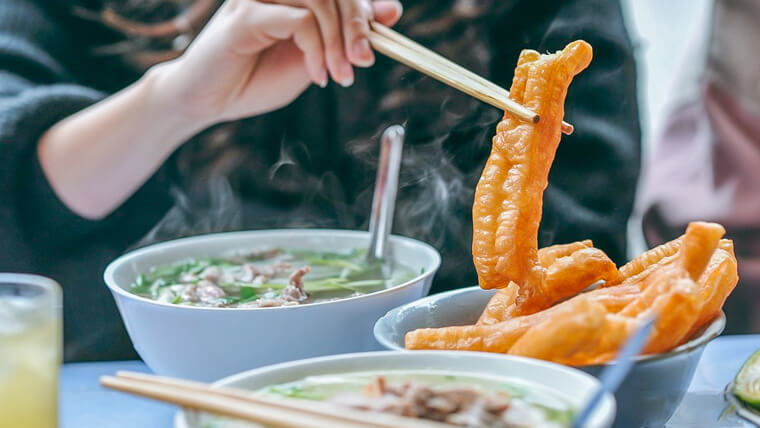
Quay is an indispensable side dish for Pho - Source: dulich.laodong
Quay (bagel twists) is a familiar Vietnamese side dish in particular and in Asian countries in general, made from flour, mixed with baking powder, and fried to golden. Quay comes in the form of a pair of long buns, the size of small sausages, rolled together, with a nutty taste like bread but more crunchy. People often eat them together with porridge, or noodle dishes such as Vietnamese chicken pho, Vietnamese bun rieu cua,… or even eat them as a snack. If you go to a Vietnamese Pho restaurant, in addition to the raw vegetables, you may come across a plate of golden bagel twists right next to it.
As one of the easy Vietnamese side dishes, how to make this dish is also quite simple, just mix flour, baking powder, sugar, salt, and water together, then add chicken eggs and incubate for about 1 hour. The dough is then rolled into a long-form and flattened into 8 - 10 cm lengths, two of which are then stacked to form a doughnut. The maker then drops them into a pan of boiling oil, stirring them until they are golden in color, crispy, and emitting an attractive smell.
Note that Quay also contains additives and grease that can be harmful to the health of the eaters such as causing gastritis, intestinal inflammation, and memory impairment,... The high aluminum content in this Vietnamese side dish can cause premature aging, inhibit phosphorus absorption and interfere with calcium metabolism, making bones thin and fragile. In addition, many restaurants often reuse fat and oil for frying, which is easy to create toxins that affect liver function.
4 - Authentic Vietnamese side dishes from salads
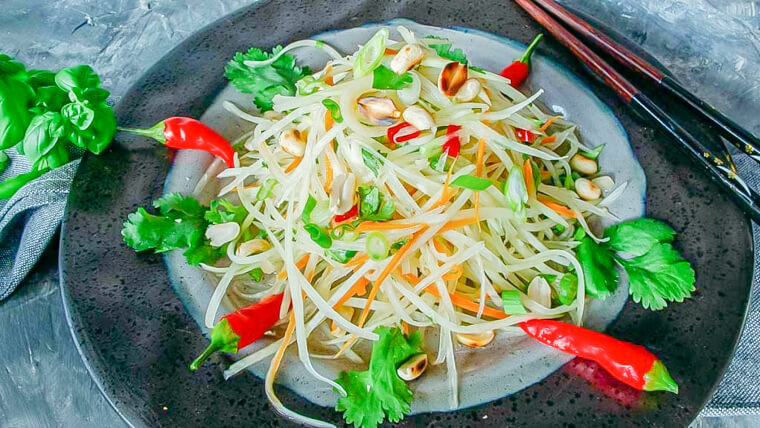
Papaya salad - Source: saltandpestle
This familiar Vietnam side dish is called by different names in each region, in the North, it is “nộm” and in the South, it is “gỏi”. But whatever the name, they all have many similarities including a similar cooking method, using vegetables mixed with sweet and sour sauce, vinegar, some spices, peanuts, and sometimes meat. Considered a dish in between pickles and raw vegetables, they often have a mildly sour taste, that is cool and easy to eat. The method is also quite simple: wash all vegetables and cut them into small pieces, squeeze lemon, fish sauce, sugar, and/or vinegar and mix well, and sprinkle sesame, roasted peanuts, and chili on top.
Some famous Vietnamese side dishes that can be mentioned are lotus root salad, Banana blossom salad, shredded chicken salad, morning glory salad, and dried beef salad. There are many traditional nộm dishes that must be included in the Northern Vietnamese New Year, including kohlrabi/papaya, carrots, roasted peanuts, coriander,... The delicious salad must not be crushed, the vegetable fibers are crispy, fragrant with the smell of sesame and peanuts, mixed with the sweet, spicy, salty, and sour taste.
Vietnamese side dishes are extremely diverse, most of them have a cool, sour taste, helping to increase appetite. Not only do they make food easier to swallow and you eat more, but these side dishes also sometimes add many important nutrients. However, you still need to do your research before eating anything, and we - Localtravelidea would be happy to help with the detailed information on our website.







.jpg) — Ha Bich
— Ha Bich



